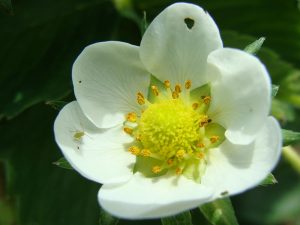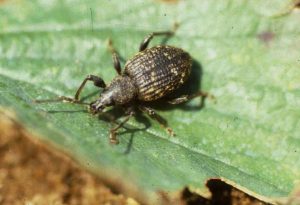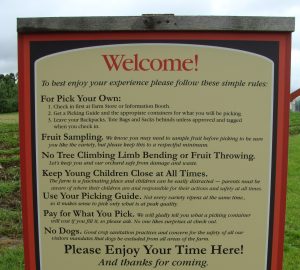Strawberry IPM Newsletter No. 5 — June 9, 2023
HARVEST BEGINS IN SOUTHERN MAINE
Prolonged Wet Weather Continues to Make Diseases a Concern

Situation: Continued cool, wet weather has slowed strawberry development, but some fruit is being harvested from southern beds grown on black plastic mulch and under rowcovers. However, late varieties are still in bloom in northern matted row plantings. Insect counts have generally been increasing but remain below control thresholds in most fields.
Strawberry bud weevil: Clipper damage was over threshold on very late blooming varieties at two locations this week, and we found the damage more widely distributed among our scouting sites. However, most fields in southern Maine are beyond the stage when clipper can cause significant damage. Only very late blooming varieties could still be at the flowering stage where buds could be significantly impacted.
Tarnished plant bug: Plant bug nymphs were more widely distributed in flowering fields this week, but only one site was over the recommended spray threshold of more than 4 nymphs per 30 flower clusters sampled. We recommend scouting for nymphs frequently through the bloom period. They may appear quickly if we get a spell of warmer, drier weather.
Two-spotted spider mites: Spider mites were more widespread this week and were over the spray threshold of 25% of leaves infested in two locations. Once warmer, drier weather moves in, expect mite populations to increase in fields where they are at low levels now. It is important to keep scouting regularly to be aware of when mites are becoming a problem.
Sap beetles: These insects may become a problem when berries start to ripen. The small, dark brown beetles chew holes in ripening fruit, similar to slug injury. They may be found in the holes they’ve chewed, but often drop to the ground when disturbed. The best management strategy for sap beetles is good sanitation. Keep the field free of overripe fruit by picking often and thoroughly. Insecticide sprays for this pest can be effective but should be a last resort during the harvest period. Assail®, Brigade®, Dibrom® and PyGanic® are registered for control of sap beetles with pre-harvest intervals ranging from 12 to 24 hours. Read the product label carefully for this and other application instructions and restrictions.

Black vine weevil & strawberry root weevil: Black vine weevils and strawberry root weevils usually begin to emerge and start feeding on strawberry foliage during the harvest season. Look for notching along the leaf edges and the presence of the black or brown snout beetles. The weevils feed mostly at night and spend the daylight hours at the base of the plants under the mulch. They lay eggs at the base of the crowns during the harvest and post-harvest period. The larvae, or grubs, feed on the strawberry plant roots through the fall, overwinter deep in the soil and start feeding again in the spring, causing plants to weaken and die. Badly infested beds should be plowed up as soon after harvest as possible. Bifenthrin (Brigade®) can be applied to kill the adults when they emerge and start to feed on the leaves (usually until mid-late July). Applications should be made at night when the insects are active, and the highest rate of the insecticide should be used. Platinum® can be applied in the fall as a soil drench to control grubs before they go into the winter.
Diseases: With all damp weather we have experienced in the past week, conditions have been very favorable for gray mold. Once spray materials have dried on the plants, they are generally considered “rainfast”, unless there is more than one inch of rainfall. should more than one inch of rain occur following a spray, or there has been significant shoot or flower growth since the last application, another fungicide application should be applied to assure adequate protection.

Powdery Mildew: We found a couple of fields with low levels of powdery mildew on foliage this week. The symptoms of this disease include upward curling of the leaves, purple or reddish blotches on the petioles, and the white, powdery fungus on the undersides of the leaves. These infections will weaken plants and can reduce yield the following year. When selecting a fungicide for botrytis fruit rot, use a material that is also effective against powdery mildew such as Captan®, Topsin-M®, Pristine®, or Cabrio®, or tank mix the gray mold product with a good powdery mildew product such as Quintec® or Procure®.
Leaf spot and leaf scorch are becoming more prevalent in fields this week, due to the cool wet weather, but in most cases, infections remain at low levels. Some fungicide products applied to manage gray mold can control leaf spots as well, including Captan®, Cabrio®, Rally® and Pristine®.
Annual Pre-Harvest Checklist for Pick-Your-Own

Is your farm ready to provide your customers with the best possible picking experience?
- Your phone message and web/social media pages with picking conditions and opening and closing times are up to date and regularly updated.
- There is easy access to the fields and plenty of parking. If possible, entries and exits should be on opposite sides of the lot to reduce cross traffic and congestion.
- Someone is ready to greet customers and offer parking instructions and directions to the field
- Access to the field is free of hazards. Use flags to mark where the last customer stopped picking, and the next should begin.
- Transportation is provided for the elderly and disabled.
- The rules regarding picking, sanitation and traffic flow are clearly posted.
- Someone is in the field to show customers where to pick, explain picking guidelines, and to answer questions.
- Restroom and hand washing facilities are available and regularly cleaned and sanitized. Customers should wash hands before entering the field. Instructions for proper hand washing should be posted.
- The checkouts are fast and efficient. Scales and countertops should be sanitized frequently. The entry and exit from the checkout should be one way; no cross traffic.
- Beverages are available.
- Shade and seats are available for customers wanting to rest.
- The help is friendly and knowledgeable.
A friendly, clean, and organized atmosphere will leave a lasting impression on your customers, encouraging them to come back and to recommend your farm to their friends.
2022-2023 New England Small Fruit Management Guides is the latest edition of the Guide.
Sincerely,
David T. Handley
Vegetable & Small Fruit Specialist
Highmoor Farm
P.O. Box 179
Monmouth, ME 04259
207.933.2100
Pest Management Unit
17 Godfrey Drive
Orono, ME 04473
1.800.287.0279
Where brand names or company names are used, it is for the reader’s information. No endorsement is implied nor is any discrimination intended against products with similar ingredients. Always consult product labels for rates, application instructions and safety precautions. Users of these producers assume all associated risks.
The University of Maine is an equal opportunity/affirmative action institution.
